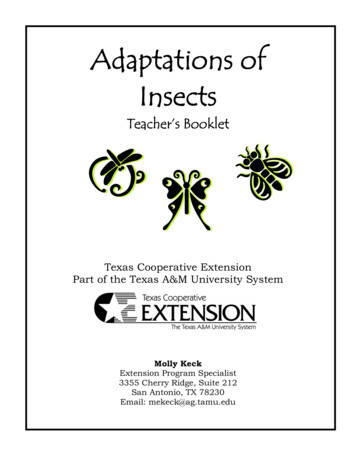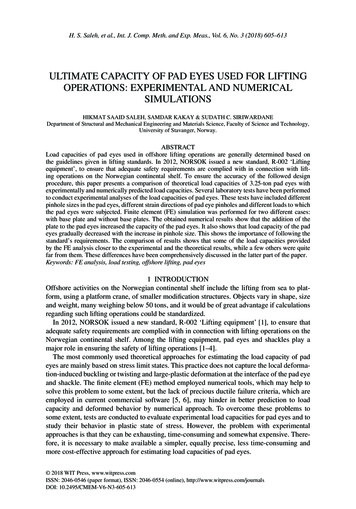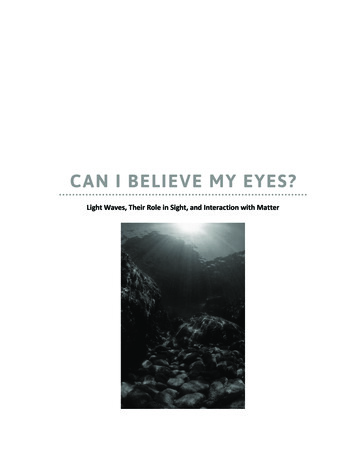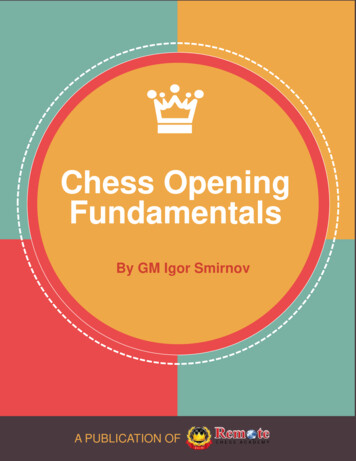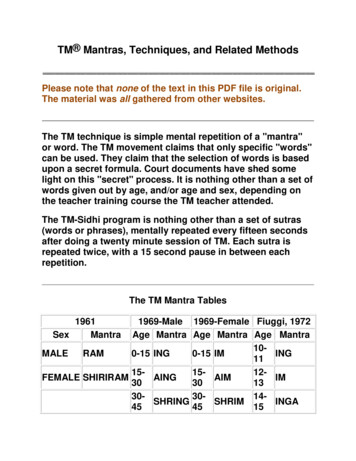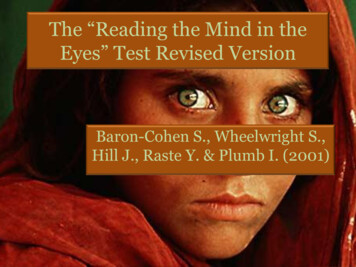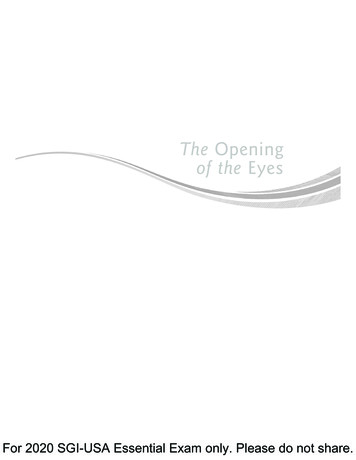
Transcription
The Openingof the EyesFor 2020 SGI-USA Essential Exam only. Please do not share.
For 2020 SGI-USA Essential Exam only. Please do not share.
For 2020 SGI-USA Essential Exam only. Please do not share.
Published byWorld Tribune Press606 Wilshire Blvd.Santa Monica, CA 90401 2012 by the Soka Gakkai All rights reserved.Printed in the United States of America.Design by Lightbourne, Inc.Source artwork: www.istockphoto.comISBN 978-1-935523-34-524 23 22 21 204 5 6 7 8For 2020 SGI-USA Essential Exam only. Please do not share.
ContentsEditor’s Note . . . . . . . . . . . . . . . . . . . . . . . . . . . . . . . viiPreface: “Opening of the Eyes”—A Call To Open OurEyes to Nichiren, To Open Our Eyes to the People . . . . . . . . . . . 1Introduction . . . . . . . . . . . . . . . . . . . . . . . . . . . . . . . . 31The Three Virtues—Sovereign, Teacher andParent—Establishing the Buddhism of the PeopleThrough Compassion and Enduring Persecution . . . . . . . . . . . 152The “Teaching Hidden in the Depths of theSutra”—The Supreme Law That Opens the Path toBuddhahood for All People . . . . . . . . . . . . . . . . . . . . . . . 253Original Cause and Original Effect—EternalBuddhahood and the Unending Bodhisattva WayAre Opened Through Faith . . . . . . . . . . . . . . . . . . . . . . . 334The Fivefold Comparison—Clarifying the Causality ofLife and the Fundamental Direction for Human Existence . . . . . . 435A Vow for the Enlightenment of All People—The PowerDeep Within Our Lives That Can Overcome All Obstacles . . . . . . 516The Votary of the Lotus Sutra—One Who Practicesthe Correct Teaching With Outstanding Perseveranceand Compassion . . . . . . . . . . . . . . . . . . . . . . . . . . . . . 597The Profound Debt Owed to the Lotus Sutra and theProtection Received by Those Who Spread the SupremeLaw of Universal Enlightenment . . . . . . . . . . . . . . . . . . . . 678The Six Difficult and Nine Easy Acts—To Discard theShallow and Seek the Profound Is the Way of a Personof Courage . . . . . . . . . . . . . . . . . . . . . . . . . . . . . . . . 77vFor 2020 SGI-USA Essential Exam only. Please do not share.
9The Two Admonitions of the “Devadatta” Chapter—ACall To Lead All People to Enlightenment Based on theTeachings of Changing Poison Into Medicine and AttainingBuddhahood in One’s Present Form . . . . . . . . . . . . . . . . . . 8510The Three Powerful Enemies, Part 1—The Anatomy ofPersecution Arising From Fundamental Darkness . . . . . . . . . . . 9511The Three Powerful Enemies, Part 2—Confronting the MostFormidable Enemy: Arrogant False Sages . . . . . . . . . . . . . . . 10312Why the Votary of the Lotus Sutra Encounters GreatPersecutions—The Votary’s Battle Against the FundamentalEvil of the Slander of the Law . . . . . . . . . . . . . . . . . . . . . 11313“I Will Be the Pillar of Japan”—Standing Alone andDedicating One’s Life to the Vow for Kosen-rufu . . . . . . . . . . . 12314Lessening One’s Karmic Retribution—The Principle ofChanging Karma That Frees People From Suffering . . . . . . . . . 13315“I and My Disciples”—Attaining Buddhahood ThroughSteadfast Faith at the Crucial Moment . . . . . . . . . . . . . . . . 14316Shakubuku—A Lion’s Roar of Great Compassion ToRefute Error and Spread Good . . . . . . . . . . . . . . . . . . . . 15117The Sovereign, Teacher and Parent of the Buddhism ofSowing of the Latter Day of the Law, Part 1 . . . . . . . . . . . . . 16118The Sovereign, Teacher and Parent of the Buddhism ofSowing of the Latter Day of the Law, Part 2 . . . . . . . . . . . . . 16919Enjoying Infinite Benefit Throughout Eternity—TheBoundless Joy of a Life of Unceasing Challenge Basedon the Mystic Law . . . . . . . . . . . . . . . . . . . . . . . . . . . 175Notes . . . . . . . . . . . . . . . . . . . . . . . . . . . . . . . . . . 183Index . . . . . . . . . . . . . . . . . . . . . . . . . . . . . . . . . . 209viFor 2020 SGI-USA Essential Exam only. Please do not share.
Editor’s NoteThis series of lectures by SGI President Ikeda were published in SGI-USA’sLiving Buddhism from the November 2004 issue to the April 2005 issue,the June 2005 issue to the December 2005 issue and the January–February2006 issue to the July–August 2006 issue.Please also see The Writings of Nichiren Daishonin, vol. 1, pp. 220–98,for “The Opening of the Eyes.” GZ, page number(s)—refers to the Gosho zenshu, the Japanese-languagecompilation of letters, treatises, essays and oral teachings of NichirenDaishonin. LSOC, page number(s)—refers to The Lotus Sutra and Its Opening andClosing Sutras, translated by Burton Watson (Tokyo: Soka Gakkai, 2009). OTT, page number(s)—refers to The Record of the Orally Transmitted Teachings, translated by Burton Watson (Soka Gakkai: Tokyo, 2004). WND, page number(s)—refers to The Writings of Nichiren Daishonin,vol. 1 (WND-1) (Tokyo: Soka Gakkai, 1999) and vol. 2 (WND-2) (Tokyo:Soka Gakkai, 2006).viiFor 2020 SGI-USA Essential Exam only. Please do not share.
For 2020 SGI-USA Essential Exam only. Please do not share.
Preface“Opening of the Eyes”—A CallTo Open Our Eyes to Nichiren,To Open Our Eyes to the PeopleReligion is the pillar of humanity. Philosophy is the backbone of life.The Soka Gakkai has advanced based onthe strength of its members’ solid grounding in Buddhist study, a pursuit that can belikened to the rigorous training of a masterswordsman. Opening the pages of Nichiren Daishonin’s writings with the spirit ofreceiving direct instruction and guidancefrom the Daishonin himself, members everywhere have deepened their understanding offaith, practice and study; summoned forthcourage; and emerged victorious in theirstruggles for kosen-rufu. When we advancewith Nichiren’s writings as our foundation,we will never be deadlocked.The lectures I received in my youth frommy mentor, second Soka Gakkai presidentJosei Toda, continue to resonate vibrantly inmy heart even now. His lectures covered suchtopics as life, happiness, government, culture,peace, human integrity, the principles of organization and the mentor-disciple relationship.His free and far-reaching discourses trulyrevived Nichiren Buddhism in the presentage—and, more specifically, in people’s actuallives and in society.Above all, based on Nichiren’s writings,President Toda called on people to stand upas Bodhisattvas of the Earth and work forthe genuine welfare and prosperity of theircountry. His compassionate guidance andencouragement awakened a sense of courageand mission in the depths of their lives. I amfirmly convinced that in the seven hundredyears following the Daishonin’s death, no onehad ever read his writings from the perspective that all people are Bodhisattvas of theEarth. President Toda, however, lectured onthe Daishonin’s teachings based on his owninner awareness and sense of mission as aBodhisattva of the Earth, which he gained asa result of his spiritual awakening in prisonduring World War II.It goes without saying that PresidentToda’s lectures also played a pivotal and decisive role in my own life. In fact, my first fatefulencounter with my mentor (on August 14,1947) took place during one of his lectures onthe Daishonin’s treatise “On Establishing the1For 2020 SGI-USA Essential Exam only. Please do not share.
The OPENING of the EYESCorrect Teaching for the Peace of the Land.”After joining the Soka Gakkai, I attended hislectures on the Lotus Sutra, and later I wasable to have early-morning study sessions withhim, during which he discussed the profoundphilosophy and principles of Nichiren Buddhism. President Toda was truly a masterin giving lectures. I was so impressed that Iremember thinking, There are three kinds of lectures: unskilled, skilled and artistic—Mr. Toda’sbelonged to the last category. As President Toda’sdisciple, I also exerted myself on the front linesby giving lectures and striving to convey thegreatness of Nichiren Buddhism to as manypeople as possible.Like a lion’s roar, the truth and justiceof Nichiren Daishonin is a powerful forcefor defeating the devilish nature inherent inhuman life. The reverberations of his invincible life force that surmounted successive majorpersecutions impart courage, hope, confidenceand joy to those challenging painful obstaclesand hardships. His words of profound contemplation and introspection teach us thecorrect path of kosen-rufu and life. For thatreason, making his writings our foundation isalso the correct path leading to victory both inlife and in our struggle for kosen-rufu.We of the SGI aspire to make the twentyfirst century an age of the victory of thepeople, the victory of youth and the victory ofhumanity. Now, more than ever before, peoplearound the world are searching for a humanistic religion. Out of the hope that it mayserve as a key for ushering in such an age andbecome a source of inspiration and growth formy fellow SGI members everywhere, I havedecided to embark on a new series of lectureson “The Opening of the Eyes,” an importantwriting embodying the great lion’s roar of theDaishonin. Toward realizing a century of lifeand a century of humanity, I would like todiscuss the essence of Nichiren Buddhismand the steadfast commitment of the SGI, anorganization that has inherited the true spiritof the Daishonin. I would also like to leavebehind a solid spiritual foundation for theSGI of the future.Philosophy is what empowers our struggle to be victorious in life. All of you who areearnestly studying and internalizing NichirenBuddhism, an extremely lofty and profoundpractical philosophy, are certain to becomeeternal “doctors of philosophy.” I began thisseries of lectures with the ardent prayer thateach of you will illuminate the deepeningdarkness of modern society with the brilliant light of the Daishonin’s writings—theeternally treasured teachings of hope—anddevelop into courageous people of philosophywho will build a century of humanity.DAISAKU IKEDANovember 18, 20062For 2020 SGI-USA Essential Exam only. Please do not share.
IntroductionThe central theme of Nichiren Daishonin’slengthy two-part treatise, “The Openingof the Eyes,” can indeed be summed up in theshort phrase opening the eyes.While the Daishonin’s original text of thiswriting is not extant, there is a record indicating that it consisted of a total of sixty-sixpages: sixty-five sheets of paper for the bodyof the work and one sheet of paper on whichthe Daishonin himself had written “TheOpening of the Eyes” as the title page.1“Opening the eyes” means exactly that:“to open the eyes.” It can also be read as theDaishonin’s call: “Open your eyes!”How can we open the closed eyes ofpeople’s hearts? With what light can weilluminate the darkness of ignorance?2 It isNichiren Daishonin, the Buddha of the LatterDay of the Law, who opened a path to answerthese questions.The flame of Nichiren’s struggle as thevotary of the Lotus Sutra—a struggle aimedat leading humanity to enlightenment andactualizing the principle of “establishing thecorrect teaching for the peace of the land”while battling against all manner of devilishfunctions—only burned even more brightlywhen he was exiled to snowbound SadoIsland. We can discern his unyielding resolveNichiren Daishonin’sWriting Paper“The Opening of the Eyes” was written on sixty-five sheets of handmadeJapanese paper. Unfortunately, becausethe original manuscript was lost when agreat fire raged through Minobu in 1875,there is no way to confirm exactly whichkind or size of paper it was written on.Being exiled on Sado Island obviously made it difficult for the Daishoninto procure paper, as he confirms whenhe writes, “There is very little writingpaper here in the province of Sado”(“Letter from Sado,” WND-1, 306). How,then, did he obtain sufficient paper towrite “The Opening of the Eyes” andother treatises and letters while in exile?Historians speculate that, while hewas staying at Echi* immediately after theTatsunokuchi Persecution (in September1271, which was followed by his exileto Sado at the end of October), hisdisciples may have prepared a supply ofpaper for him, or that paper may havebeen among the offerings made to himby his followers. It is also thought thatthe disciples who accompanied him toSado may have brought a large quantityof paper along with them.3For 2020 SGI-USA Essential Exam only. Please do not share.
The OPENING of the EYESUsing this paper, Nichiren continuedwriting at a furious pace even in themidst of great persecution. While inEchi, he sent numerous letters to thosefollowers who were imprisoned in theaftermath of his arrest, as well as to TokiJonin, Shijo Kingo, Ota Jomyo and others.And during the journey from Echi toSado and immediately after his arrival atSado, he not only wrote a steady streamof letters to his followers, but also composed the treatise “The Opening of theEyes.” The voluminous body of lettersand treatises he produced during thatperiod attests to his strenuous and unremitting effort to encourage his followers.* Echi: A fief held by Homma Rokuro Saemon, thedeputy constable of Sado Island. It was located inwhat is now Atsugi City in Kanagawa Prefecture,adjacent to Tokyo. After the TatsunokuchiPersecution, which occurred on September 12,1271, Nichiren was held in custody at Homma’s residence at Echi before being taken to exile on Sado onOctober 10, arriving there on October 28.from the following well-known passage of“The Opening of the Eyes”: “This I will state.Let the gods forsake me. Let all persecutionsassail me. Still I will give my life for the sake ofthe Law . . . Here I will make a great vow . . .I will be the pillar of Japan. I will be the eyesof Japan. I will be the great ship of Japan.This is my vow, and I will never forsake it!”(WND-1, 280–81).From the standpoint of society, he wasan exile. Though he was the victim of persecution by the powerful and was innocent ofthe charges brought against him, he foundhimself sentenced to exile, a penalty secondin severity only to execution,3 and placedin a veritable prison of nature. As was to beexpected, however, no chains of any formcould ever shackle his spirit.Throughout the pages of human history,there are many wise people and sages whobravely endured attack and oppression. TheDaishonin stands out among them for havingdeclared his intent to save all humankind andsecured the path to do so while exiled underthe harshest of conditions. “I will be the pillarof Japan,” he cried invincibly. No persecutionor devilish force could hinder the Daishonin,who had stood up to fulfill his vow to lead allpeople to enlightenment.A person awakened to the inherent Lawof life can truly become a colossus of thenoblest human spirit.Nichiren Buddhism is a “religion for allhuman beings.” It was Nichiren who firmlyestablished the great path of the “humanreligion” elucidated in the Lotus Sutra, theessence of Mahayana Buddhism, and wholeft behind the means for all people to realizegenuine happiness and lasting peace.The Daishonin is truly the “pillar,” the“eyes” and the “great ship” of all humankind.However, the befuddled rulers of Japan of hisday, as well as perverse and fawning priestsdwelling in the world of animals,4 tried totopple this pillar.Writing in the Midst ofExtreme ConditionsIn another writing, “The Actions of theVotary of the Lotus Sutra,” NichirenDaishonin gives a detailed account of howhe came to compose “The Opening of theEyes”: “After everyone had gone [following4For 2020 SGI-USA Essential Exam only. Please do not share.
INTRODUCTIONthe Tsukahara Debate,5 held in January1272, on Sado], I began to put into shape awork in two volumes called The Opening ofthe Eyes, which I had been working on sincethe eleventh month of the previous year.6 Iwanted to record the wonder of Nichiren,in case I should be beheaded. The essentialmessage in this work is that the destinyof Japan depends solely upon Nichiren.A house without pillars collapses, and aperson without a soul is dead. Nichiren isthe soul of the people of this country. Heino Saemon has already toppled the pillarof Japan, and the country grows turbulentas unfounded rumors and speculation riseup like phantoms to cause dissention in theruling clan. Further, Japan is about to beattacked by a foreign country, as I describedin my On Establishing the Correct Teaching.Having written to this effect [in The Opening of the Eyes], I entrusted the manuscript toNakatsukasa Saburo Saemon-no-jo’s [ShijoKingo’s] messenger” (WND-1, 772).In this passage, the Daishonin recalls hissentiments in writing “The Opening of theEyes,” which he completed in February 1272.He begins by saying that he started planningthe treatise in November 1271, immediatelyafter arriving on Sado on October 28.Nichiren reached Tsukahara on Sado onNovember 1, amid extremely frigid temperatures. The place where he initially stayed wasa dilapidated shrine called the Sammai-do,in the middle of a graveyard. He writes that“it stood on some land where corpses wereabandoned” (“The Actions of the Votary ofthe Lotus Sutra,” WND-1, 769). It was a tinystructure consisting of a single room withfour posts. No statues of the Buddha wereenshrined there; the boards of the roof did notShijo KingoWhile “The Opening of the Eyes” wasaddressed to all of Nichiren Daishonin’sfollowers, it was specifically sent toShijo Kingo. This is also evident fromsuch statements relating to this treatise as: “I entrusted the manuscript toNakatsukasa Saburo Saemon-no-jo’s[Shijo Kingo’s] messenger” (“TheActions of the Votary of the LotusSutra,” WND-1, 772), and “As for matters of doctrine, I have discussed themin the work that I sent earlier to ShijoSaburo Saemon-no-jo [Shijo Kingo].Youshould read that work very, very carefully” (“Why No Protection from theHeavenly Gods?,” WND-2, 432).In fact, a messenger, dispatchedwith various offerings by Shijo Kingoout of concern for Nichiren’s welfare,visited Sado Island in February 1272.Nichiren apparently had this messengerdeliver the treatise to Shijo Kingo,with the understanding that the latterwould ensure that it was read by allhis followers in Kamakura.The Daishonin held Shijo Kingo inthe highest esteem for having accompanied him at the time of the TatsunokuchiPersecution, ready to die at his side. Hewrites in famous praise of his disciple’saction: “In what lifetime could I possiblyforget it?” (“The Place of the Clusterof Blessings,” WND-1, 1069), and “Thiscan only be called wondrous” (“ThePersecution at Tatsunokuchi,” WND-1,196). It is not difficult to imagine, therefore, that Shijo Kingo was chosen as therecipient of “The Opening of the Eyes,”because he was not only one of theleading followers in Kamakura but also adisciple who embodied the spirit of not5For 2020 SGI-USA Essential Exam only. Please do not share.
The OPENING of the EYESbegrudging one’s life for the sake of theLaw.*In “The Opening of the Eyes,”Nichiren states that he is writing thistreatise to send to his “close disciples”as a “keepsake” from him (see WND-1,269), and stresses the importance ofreading it based on faith that is infusedwith a spirit of selfless dedication toBuddhism.* “Not begrudging one’s life” means not sparingeven our own lives in seeking to spread the MysticLaw and to pursue Buddhism. This phrase appears in“Encouraging Devotion,” the 13th chapter, and elsewhere in the Lotus Sutra.meet, and the walls were full of holes. It waslittle more than a deserted shack.In an extreme environment where icywinds blew mercilessly and snow piled high,he placed fur skins on the floor to lie or sit onand spent his days and nights wrapped in astraw coat. In addition to the freezing northern winter to which he was unaccustomed,he also faced a shortage of food provisions.As a result, during November, he sent backsome of the young disciples who had accompanied him.“It is impossible to describe these matters in writing” (“Aspiration for the BuddhaLand,” WND-1, 214), the Daishonin says,referring to the deplorable conditions thatconfronted him on Sado. He admits to feelingas though he had passed through the realmof hungry spirits and fallen alive into one ofthe eight cold hells 7 (see “Letter to Horen,”WND-1, 519). He also observes: “Exiles tothis island seldom manage to survive. Even ifthey do, they never return home. So no oneis going to be punished for killing an exile”(“The Actions of the Votary of the LotusSutra,” WND-1, 771).In such a perilous environment,Nichiren immersed himself deep in thoughtand composed an important work for theenlightenment of humankind. Over the courseof approximately three months, he plannedout and wrote this treatise, which, in termsof current Japanese standard, four hundredcharacter manuscript pages, comes to morethan one hundred pages in length. Afterarriving on Sado, he set to work right away onthis task to lead all people to Buddhahood.Discussing the Daishonin’s spiritual statewhile on Sado, President Toda once remarked:“Buddhahood is a state of absolute happiness.A state of being that at each moment is likea translucent ocean or a cloudless sky, utterlyinvincible and fearless—this is how I perceivethe Daishonin’s state of life during his exileon Sado.“When the Daishonin says, ‘Sacrificingyour life for the Lotus Sutra is like exchanging rocks for gold or dung for rice’ (“TheActions of the Votary of the Lotus Sutra,”WND-1, 764), and ‘For what I have done,I have been condemned to exile, but it is asmall suffering to undergo in this present lifeand not one worth lamenting. In future livesI will enjoy immense happiness, a thoughtthat gives me great joy’ (“The Opening of theEyes,” WND-1, 287), I keenly feel that thisportrays the state of life of the Buddha of theLatter Day.”8In fact, while living under conditions ofindescribable hardship, Nichiren earnestlypondered the question of how he couldenable all people to attain Buddhahood; andhe clearly constructed the means for achieving this goal by writing “The Opening of6For 2020 SGI-USA Essential Exam only. Please do not share.
INTRODUCTIONthe Eyes” and “The Object of Devotion forObserving the Mind.” As I have said, whatsets the Daishonin apart in greatness fromcountless other historic figures who haveendured persecution is that he, amid extremedifficulties, laid a solid foundation to thoroughly secure the path for the enlightenmentof all humanity.“The Opening of the Eyes”Was Written After NichirenRevealed His True IdentityIn the passage from “The Actions of theVotary of the Lotus Sutra” that I cited earlier,Nichiren says that his purpose in writing “TheOpening of the Eyes” was to leave a recordfor posterity of the “wonder of Nichiren.”We can surmise that the greatest “wonder ofNichiren” that he seeks to record here is hiscasting off his transient status and revealinghis true identity at the time of the Tatsunokuchi Persecution.On the occasion of his near-execution atTatsunokuchi, the Daishonin discarded histransient aspect as “an ordinary person at thestage of hearing the name and words of thetruth” (that is, someone who has taken faithin the Lotus Sutra) and revealed his true stateof life as “the Buddha of limitless joy enlightened from time without beginning,” a stateof complete freedom that is at one with theeternal Mystic Law.As a result of the Daishonin casting offthe transient and revealing the true, the pathto attaining enlightenment in one’s presentform—whereby we can manifest Buddhahoodin our ordinary mortal lives, just as we are—was opened to all people.As he describes in detail in “The Openingof the Eyes,” he won this fundamental victoryof life—the victory of casting off the transient and revealing the true—in the course ofhis relentless struggle to surmount persecution after persecution and triumph over allobstacles. In the same way, when we maintaincourageous faith, unafraid of any obstacles,then, no matter what happens, we, too, candefeat the darkness of ignorance and establisha self that manifests our enlightened Dharmanature.9 This is how we cast off our own transient aspect and reveal our true selves. Castingoff the transient and revealing the true isessential to our attainment of Buddhahood inthis lifetime.As Nichiren indicates when he says,“Here a single individual has been used as anexample, but the same thing applies equallyto all living beings” (“The Unanimous Declaration by the Buddhas,” WND-2, 844), hiscasting off the transient and revealing the trueelucidates the basic principle for attainingBuddhahood that applies to all people of theLatter Day of the Law; it is also proof of thisprinciple and an example for others.All people, if they possess unwaveringfaith in the Mystic Law, can develop a stateof being as vast as the universe in their fleshand-blood lives as ordinary people. You couldsay that Nichiren Daishonin was the very firstperson to demonstrate the truth that all peopleof the Latter Day could cast off the transientand reveal the true. To verify his casting off thetransient and revealing the true and to providea “clear mirror” or means so that others coulddo the same, Nichiren manifested the Gohonzon in a concrete graphic form.7For 2020 SGI-USA Essential Exam only. Please do not share.
The OPENING of the EYESThe Daishonin is truly the pillar of allhumankind, because his example of discarding the transient and revealing the true makesit possible for all people to bring forth theirown inherent Buddha nature. Herein lies themost profound significance of his assertionsthat “the destiny of Japan depends solely uponNichiren,” and “Nichiren is the soul of thepeople of this country” (“The Actions of theVotary of the Lotus Sutra,” WND-1, 772).Opening the eyes is thus also a call “toopen your eyes to Nichiren.”Opening Our Eyes to theSpirit of “Not BegrudgingOne’s Life”Opening our eyes to Nichiren means openingour eyes to the votary of the Lotus Sutra and,therefore, also opening our eyes to the LotusSutra. In this way, multiple meanings applyto the phrase opening the eyes, as is evidentin various passages in “The Opening of theEyes.” I would now like to cite a number ofspecific passages where the Daishonin in effecturges us: “Open your eyes to Nichiren.”First of all, there is the well-known passage I quoted earlier that alerts us to open oureyes to the Daishonin’s casting off the transient and revealing the true: “On the twelfthday of the ninth month of last year [1271],between the hours of the rat and the ox(11:00 p.m. to 3:00 a.m.), this person namedNichiren was beheaded. It is his soul that hascome to this island of Sado and, in the secondmonth of the following year, snowbound, iswriting this to send to his close disciples. [Thedescription of the evil age in the “Encouraging Devotion” chapter seems] terrible, but[one who cares nothing about oneself for thesake of the Law has] nothing to be frightenedabout” (WND-1, 269).Indeed, in this passage he is saying,“Open your eyes to the ‘soul’ of Nichiren.”He essentially declares: “The ordinary personNichiren was beheaded at Tatsunokuchi. It isthe ‘soul’ of Nichiren that is now writing ‘TheOpening of the Eyes’ on Sado.” “Soul,” here,refers of course to the “Buddha of limitless joyenlightened since time without beginning”that is the true identity revealed by Nichirenwhen he cast off his transient status.Here, I would like to focus on the factthat, in terms of the overall structure of “TheOpening of the Eyes,” this passage comes rightat the start of the section where the Daishoninexplains how he read the Lotus Sutra with hislife, especially “Encouraging Devotion,” the13th chapter. In this passage, he declares thatno matter how fearful the descriptions in the“Encouraging Devotion” chapter of the waysthat the three powerful enemies will persecutethe practitioners of the correct teaching, thesethings are not in the least frightening to thesoul of Nichiren. In this way, he shows us aglimpse of the vast and fearless state of theBuddha of limitless joy enlightened since timewithout beginning.The “Encouraging Devotion” chapterdetails the terrible persecutions that will befallthe votaries of the Lotus Sutra in the evil ageafter the Buddha’s passing, describing, forexample, how the three powerful enemieswill incite the secular authorities to repressthe votaries. There is also a scene where amultitude of bodhisattvas numbering “eighthundred thousand million nayutas 10” make a8For 2020 SGI-USA Essential Exam only. Please do not share.
INTRODUCTIONvow to struggle with the spirit of not begrudging their lives when encountering suchlife-threatening persecutions. The “Encouraging Devotion” chapter contains the lines,“We care nothing for our bodies or lives /but are anxious only for the unsurpassed way”(LSOC, 233). It expounds that the intrepidspirit of not begrudging one’s life and seekingsolely to enable all people to enter the unsurpassed way to Buddhahood is a fundamentalrequisite of bodhisattvas.In “Letter from Sado,” which was writtenaround the same time as “The Opening of theEyes,” Nichiren asserts that when evil priestsseeking fame or profit conspire with ignorantofficials to unjustly attack the votary of theLotus Sutra, those with the selfless “heartof a lion king” can attain Buddhahood (seeWND-1, 302).Accordingly, we can read the phrase opening the eyes as including the meaning: “Openyour eyes to Nichiren’s spirit of not begrudging his life.”The Teacher of the Latter DayIs a Person Who ThoroughlyBattles All Obstacles andDevilish ForcesNext, I would like to read the passage in whichNichiren states his conclusion after discussingin detail how the persecutions he has encountered mirror the persecutions by the threepower
"Opening of the Eyes"—A Call To Open Our Eyes to Nichiren, To Open Our Eyes to the People R eligion is the pillar of humanity. Phi-losophy is the backbone of life. The Soka Gakkai has advanced based on the strength of its members' solid ground-ing in Buddhist study, a pursuit that can be likened to the rigorous training of a master .



